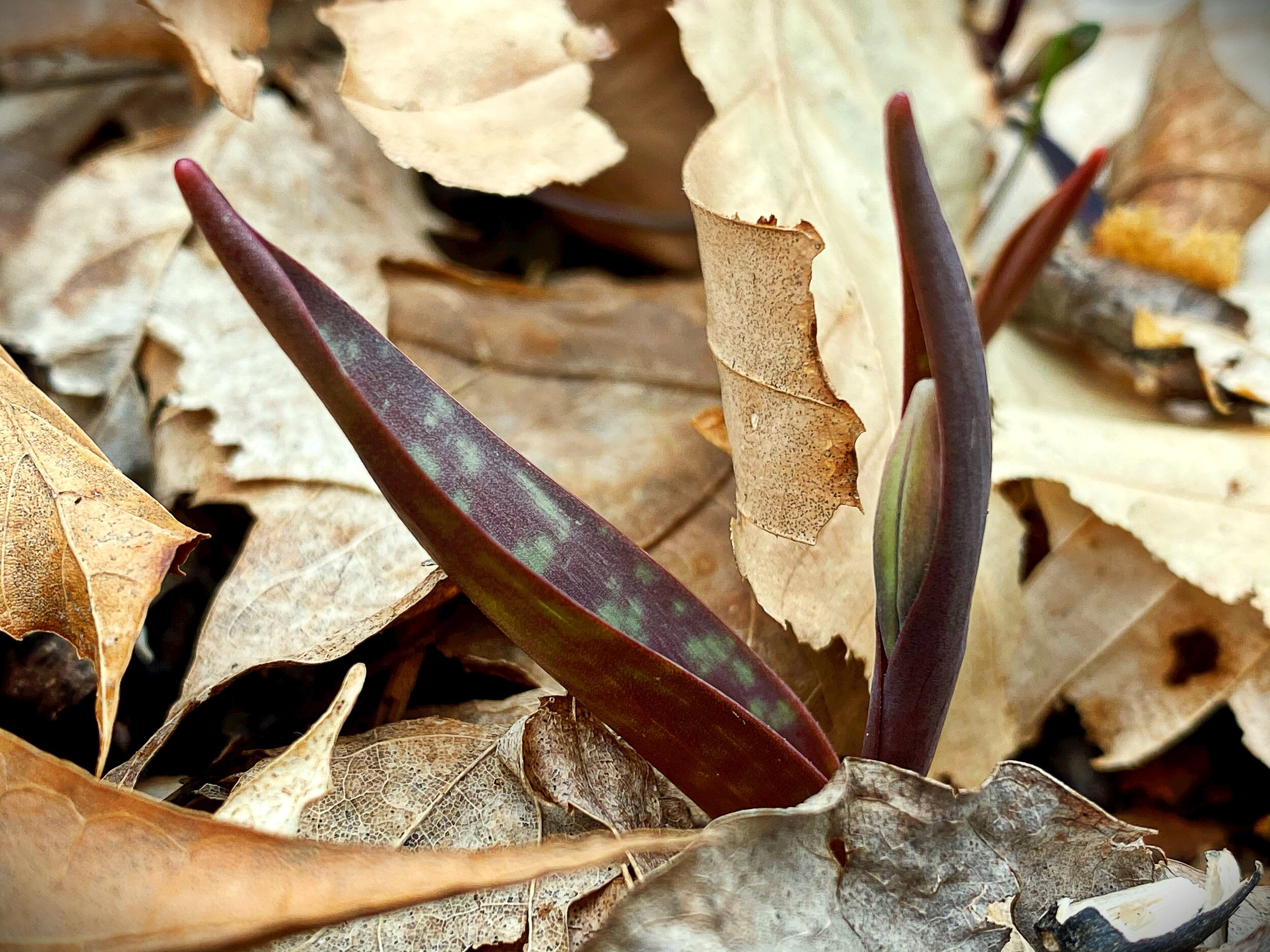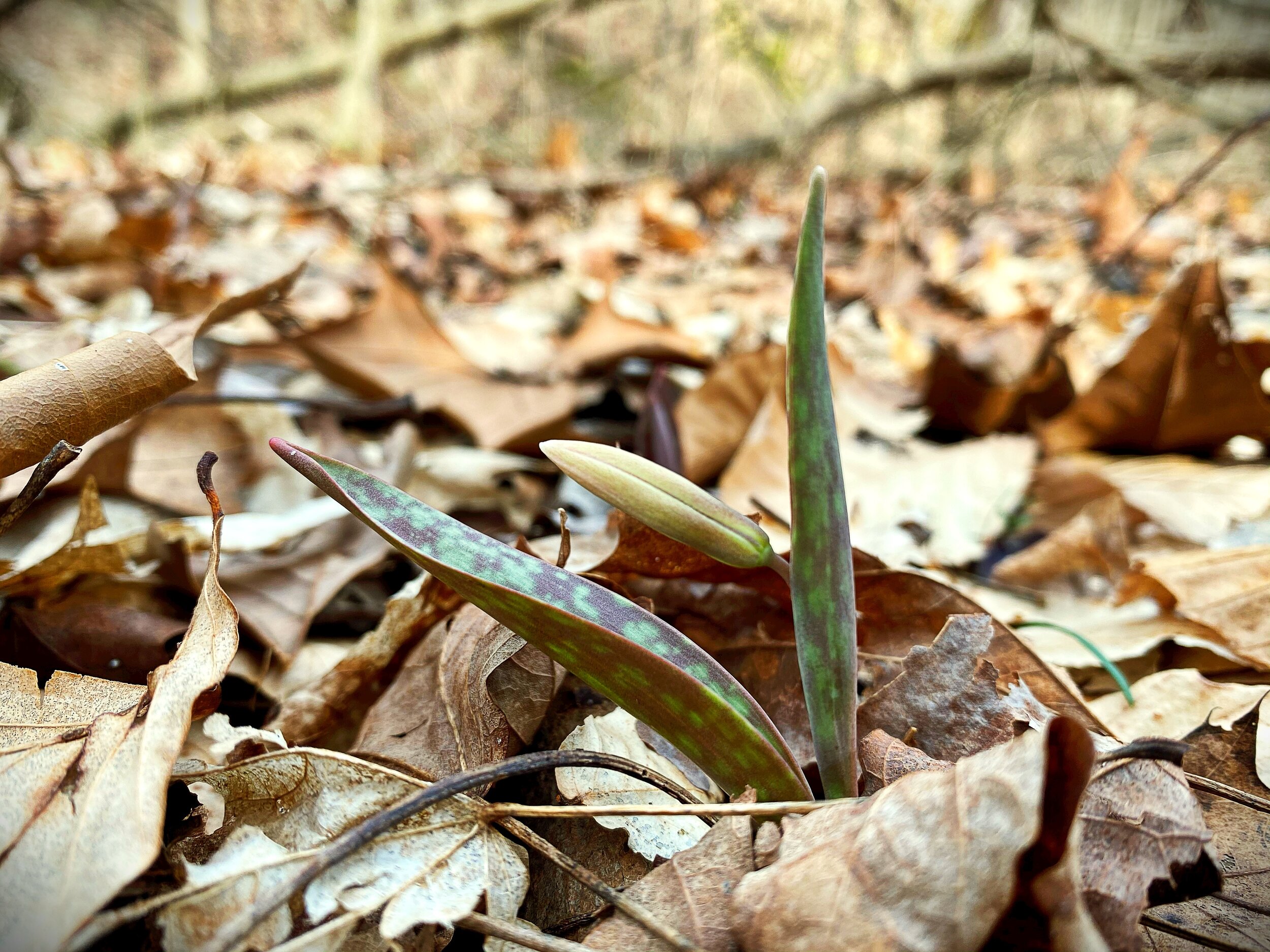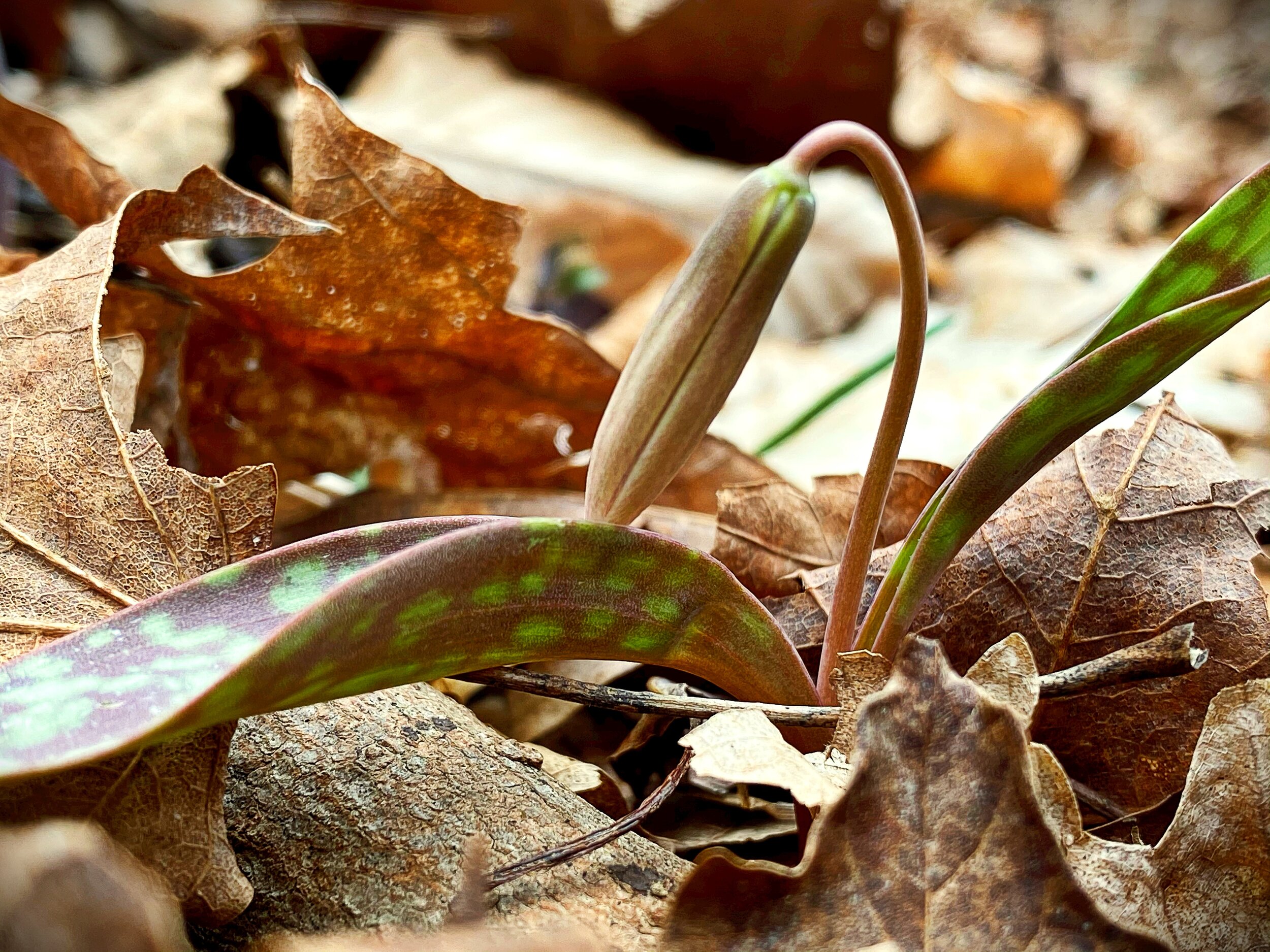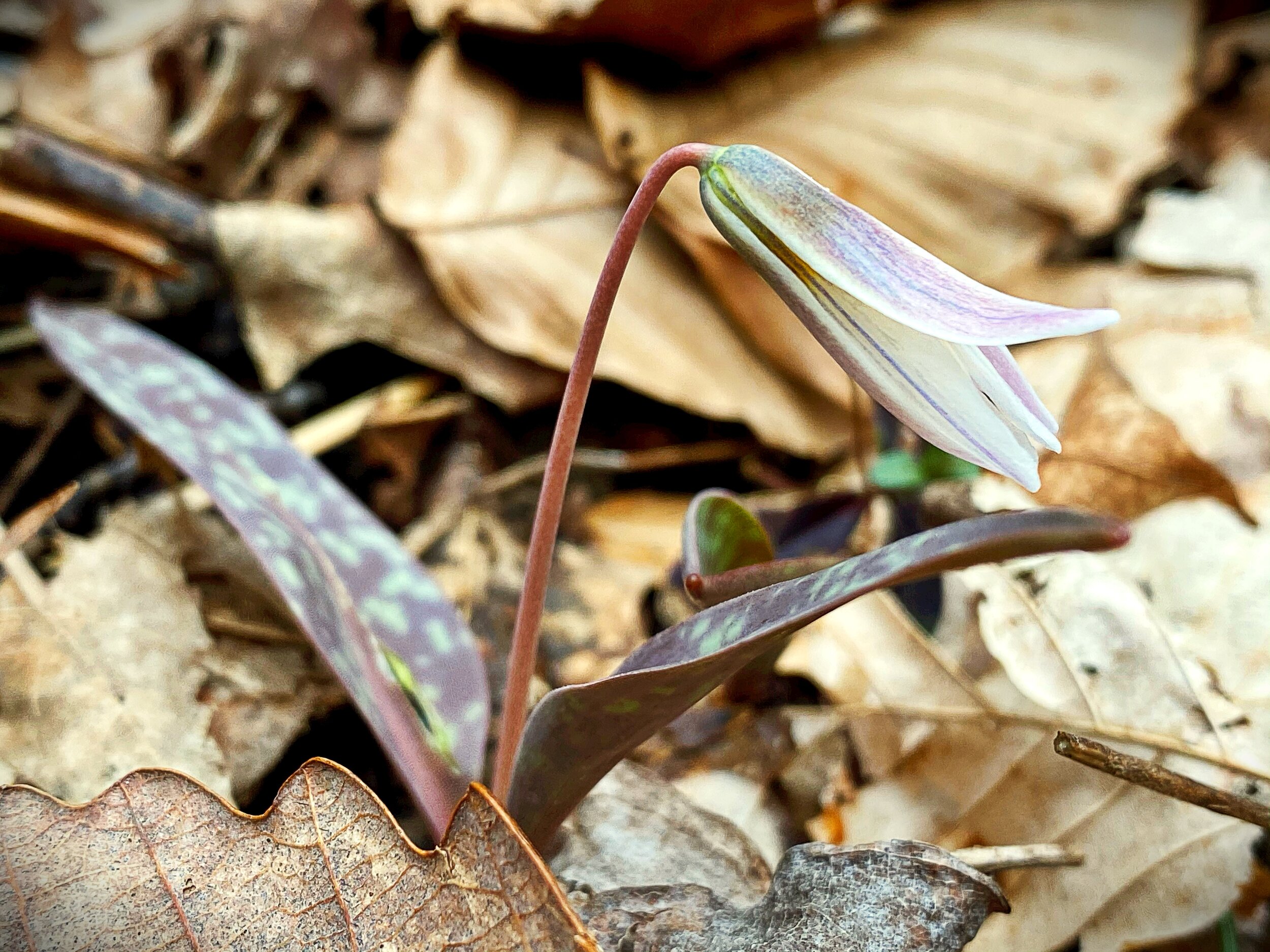March 8, 2020 ~ Patience
Kneeling down with my face this close to the earth, I can smell Spring thawing back into the soil. It is an oddly pleasurable aroma; a milieu of birth and decay, hope and transmutation - thick and heavy in the nose yet light and fluffy in the heart. All around me stand the giants, species of deciduous hardwood trees in full bloom whom are providing long awaited sustenance to yearning pollinators. Above me the morning sun shines strongly through their outstretched arms, not yet dressed for the verdant season.
The creek’s bank is soft and wavering beneath me and I, perched as Anubis, am tracing shadows across the leaf litter on the forest floor, seeking knowledge only acts of patient observation can bestow. As it has been for almost a fortnight, day in and day out I have been earnestly monitoring for the profound ephemeral emergence of an unusual woodland wildflower that, like me, calls this humble hollow home.
Although I have spent many Springs here in Appalachian Ohio being lured and delighted by its prolific beauty, I have yet to truly pay attention to how this native species comes into being each season. I’ve only paid attention to the fact that it does. Sometimes I try to trick myself into believing that I actually have knowledge about a plant simply because I can identify it by name and recite a few tidbits such as whether or not it is edible, its preferred habitat, or perhaps how many stamens and pistils can be found in its blooms.
However, collecting and reciting information is not the same as possessing the knowledge that comes from direct, thoughtful observation. As a dear friend once said, “Observation is a practice, and every practice is a deep form of witnessing”. Thus, this daily mantle has become an exercise in learning how to know better. And it is from here, on my knees, that my study of Erythronium albidum begins and from where I shall bear witness to the rise of the Trout Lilies.
Drawing by Wm. Keith Harrison, Botanical Artist
March 10, 2020 ~ Discovery
Eager eyes can play tricks on you. Of course, having never paid close attention this early in the season before, I am not exactly certain of what I am looking for. I have been doing my research, macheteing my way through the information jungle that is the internet hoping to come across some drawing or photograph of white trout lilies rising out of the soil. I was indeed surprised by the paucity of documentation about the progression of the species’ growth habit over the course of the season. I could only find this solitary image, complied by researchers looking into how young individuals of a sister species, yellow trout lily (Erythronium americanum), metabolize carbon (1). So without much to go on in regards to visual cues, I am taking the ‘wait and see’ approach, knowing that at some point in the near future there will be plentiful examples of their early growth before me.
Image taken from Gandin et al., 2011.
I know, because I have seen them here before in their full glory. Year after year they seemingly ‘appear’ out of nowhere, carpeting the moist banks of this creek like a congregation of nature’s ballet dancers; strong, embodied, yet delicately supple, graceful, authentic.
The species is capable of forming large colonies which decorate the ground with their oddly mottled leaves and dynamic white flowers in early spring, before the trees around me have had the opportunity to fully leaf out. The timing of the presence of these delightful beings is no accident. Like most of our beloved vernal woodland wildflowers, Trout Lilies soak in the sun while they are still unencumbered by the forest canopy. They can be found rejoicing in both drier upland woods as well as in the moist rich soils of forested bottomlands (2), like the one I am in now. By midsummer, they will have completely disappeared back into dormancy.
The creek bottom where my observations of White Trout Lily took place. Note species of American Beech, Yellow Buckeye, Sugar Maple. Hocking County, OH. Photo: Erika Galentin.
USDA-NRCS Range Map for White Trout Lily (Erythronium albidum).
According to some sources, white trout lily is among the widest-ranging of the eastern North American species of Erythronium (3), populations of which can be found from northwestern Minnesota to northeastern Texas eastward at least through Pennsylvania. These white trout lilies, Erythronium albidum, are one of two species of Erythronium that bless these parts of Southeast Ohio (the other, E. americanum, is a delightful, sunny yellow).
I am carefully placing each foot upon the tender earth, like making promises to do less harm than good, as I waddle back down to the creek bed. It is filled with water, well up to my ankles anyway, a sign that good, sustaining rains have come to quench the forest’s thirst. I bend down low, eyes zooming in and back out in hopes of capturing a glimpse of something I have never seen before. I could hardly contain my excitement, nor would I want to, when I finally discovered what I was seeking:
A mature White Trout Lily rising up through the leaf litter. March 10, 2020. Hocking County, OH. Photo: Erika Galentin
March 13, 2020 ~ Preparedness
As a member of the Lily family (Liliaceae) and a geophyte, white trout lilies are a long-lived perennial species who sequester their livelihood in their bulbs (or more accurately corms). This underground perennating organ not only stores valuable nutrients, it also serves as a primary mode of reproduction whereby a single individual can clone itself over and over again by sending out underground stolons that form new plants a few inches away from the mother plant…leading to an extensive population size under the right conditions (4,5). Like the ultimate underground bunker, every year the individual plant puts more energy into the development of its corm than any other structure, seconded by its foliage (6).
As a long-lived species, trout lilies are not quick to develop. Research tells us that it can take up to 5 years or more for the plant to be mature enough to flower (7). In the meantime, only a single solitary leaf will be evidence of the corm underneath. After winter dormancy, once the soils have warmed to an adequate temperature, a single shoot begins to rapidly unfurl and mature into a leaf. How long these leaves stick around for the season is controlled by the timing between warming soil temperatures and development of the overstory canopy and is therefore quite variable from year to year (no doubt another lesson in adaptability) (8). After several years of a single leaf existence, a maturing individual hopes to be replete enough to send out two leaves (very rarely a third), heralding that the time to flower has arrived.
An immature White Trout Lily with solitary leaf. This individual could be several years old. March 13, 2020. Hocking County, OH. Photo: Erika Galentin
These bulbs, or corms, are also where the species gets its other common name ‘dog tooth violet’ (not even remotely related to violets, ‘dog tooth’ apparently refers to the shape of the corm). Each year, as these corms develop, they nestle themselves deeper into the soil with the help of specialized rootlets called droppers. Some researchers reckon that the slow movement deeper and deeper into the soil protects an individual’s ‘life-vault’ from perishing with the destruction of surface disturbances and over-heated soil temperatures (9). In this way, each individual plant annually prepares for future adversity (10).
March 16, 2020 ~ Tragedy
Settling down in this hollow wasn’t an easy home-making, for neither myself or these fine white trout lilies. This land has been deeply abused, with layers upon layers of discarded household refuse and acid mine drainage still bubbling out of the soil. Indeed, it wasn’t all that long ago (less than 100 years) that thousands upon thousands of these forested foothills were routinely shaved bare.
My village in Hocking County, OH circa 1935. Note the background of completely deforested hills. Photograph complements of Millfield Mine Disaster Museum, Buchtel, OH.
In a time before the Wayne National Forest of Southeast Ohio was stitched together from parcels of abandoned, destroyed, or otherwise generally undesirable private property, this hollow here, which the locals admirably call ‘Cowshit’, pastured homestead cattle and poor folk alike. The poverty was menacing, a reflection of the indentured servantry to coal mines, iron furnaces, and brick-making factories which have long since shut down. Boom and bust, they call it. The local economy has been busted ever since, but the land was busted too. At least, that is how it appears in some of the old photographs of this place….
A coal miner’s home in nearby Glouster, OH. Date Unknown. Photo compliments of The Little Cities Archive.
Assessing land use history is an interesting element of forest appreciation; some refer to it as forest forensics whereby you can learn to make out the history of the wooded landscape not only by the species of plants growing there, but by the shapes and contours human activity has left behind. A deep mine entrance here, an old timber road there, long-abandoned home sites and family graveyards seemingly in the middle of nowhere - all miraged by the return of the forest and its trees, shrubs, and herbs.
Old barbed-wire fence, now a part of the tree. Years upon years of forest development have taken place since this fence was placed. Hocking County, OH. Photo: Erika Galentin
And the forest is returning…perhaps that is why I have fallen so deeply in love with this place. No matter how many times it gets knocked down, polluted, covered in trash, it just keeps coming back. These trout lilies here are also evidence of this...
Some ecologists have stated that the presence of woodland wildflowers, like the white trout lily, is indicative of a ‘high-quality- forest (11). This idea pleases my heart every time I come across a patch of bloodroot, rue anemone, trillium, wild garlic. But why? Why are they indicative? What is the presence of this particular epic population of white trout lily telling me about the healing of this land? As I am invested in this place, down to the vibrations in my bones, I am listening to the stories of species like the white trout lily to learn about the return of a vibrant forest ecosystem and my role in its recovery.
A mature White Trout Lily, growing up through adversity and about to be in full bloom. March 16, 2020. Hocking County, OH. Photo: Erika Galentin
March 20, 2020 ~ Community
I am thinking back on what I have learned about how large white trout lily populations like this one are partially a result of a cloning process, or vegetative reproduction. In order for this to happen there must be some relative stability in the forest environment whereby the corms and stolons of trout lily populations can evade the upheaval caused by heavy foot traffic (human or otherwise), motorized vehicles such as dirt bikes and ATV’s (my personal nemeses), equipment used for resource extraction, or other such anthropogenic apparitions.
But I am also thinking about ants…like all these little ones excavating the entrances of their nests into tidy soil mounds. They too need a peaceful landscape in order to survive and carry out a very important mission (12)…dispersing the seeds of trout lilies and other woodland herbs such as spring beauty, trillium, and bloodroot.
Aphaenogaster rudis has been identified as the primary disperser of E. americanum (14). In fact, they are a species of ant responsible for dispersing a number of native Eastern woodland species. March 20, 2020. Hocking County, OH. Photo: Erika Galentin
Myrmecochory, the dispersal of seeds by ants, is a widespread phenomenon documented in more than 70 plant families across numerous diverse habitats including deciduous forests like this one (13). And although this large stand of white trout lilies likely expanded primarily through cloning themselves, the species also reproduces by seed (an important feature of maintaining genetic diversity and intraspecific vigor). Therefore, these ants are also key characters in the success story of this white trout lily population.
The flowering and seed development of white trout lily is a highly synchronized process; after pollination by a whole host of native bees (including the Trout Lily bee, Andrena erythronii), the flowering plant switches gears, putting all of its energy and resources into the formation of its single fruit as the rest of the plant dies back for the season. Once fully developed, the capsules of the fruits are laden and thus bend over all the way to the ground where they will finally open to expose their hard, crescent-shaped seeds.
The fruit of White Trout Lily in an immature state. Eventually this fruit will get larger and heavier until it hangs to the ground and opens to reveal its seeds for the ants. April 6, 2020. Hocking County, OH. Photo: Erika Galentin
The crescent shaped seeds of White Trout Lily, after removal of eliosome. Source
Each trout lily seed is equipped with a delicious fatty appendage, or elaiosome, that the ants simply can’t ignore. Delighted by this high energy food source, the ants carry the white trout lily seeds into their nests where they then remove and consume the elaiosome and discard the intact seed in underground midden or somewhere on the mound – perfect conditions for the seed to germinate and grow a whole new plant (if the rodents and other seed predators don’t get to it first).
But in order for any of this magical community action to work, the environment for both the ants and the plants must remain relatively stable - it is this stability that has created the time and space for these healthy relationships to reestablish here in this hollow. And the success story of the white trout lily, as dependent upon some state of stability, doesn’t even end there…the community of organisms within the soil itself, whom also rely on some level of stability, play a vital role as well. For example, the mycorrhizal associations upon which the white trout lily relies for both water and nutrient uptake (14). It truly takes a village…a peaceful village.
The flowering progression of White Trout Lily. March 2020. Hocking County, OH. Photos: Erika Galentin
March 25, 2020 ~ Reciprocity
Purple Cress (Cardamine douglassii), growing in the White Trout Lily creek. March 25, 2020. Hocking County, OH. Photo: Erika Galentin
In comparison to when I started this daily observational exercise, there are so many wonderful native wildflowers sparkling this creekside; purple cress (Cardamine douglassii), spring beauties (Claytonia virginica), blue violet (Viola sororia). From my human perspective they seem to be singing in perfect harmony with their fully-blooming white trout lily neighbors.
I have pondered how this environment holds stable space for these spectacular phenomena, but being in community also requires an exchange - a giving back that supports, in some way, the vitality of others. Each member plays a contributing role in some unquantifiable homeostasis that allows not only for healing, but also for transformation. I am perched back in my observing role, knees wet with water rushing past them, fascinated by the reflection my time with the trout lilies has provided.
Yet, there is more to this white trout lily population than is meeting my eyes. Ecologists sometimes refer to it as ‘nutrient dynamics’, whereby the perfectly-timed rapid growth and decay of the aerial portions of the plant make white trout lilies, and their yellow sisters, significant contributors to the availability of important nutrients, such as nitrogen and potassium, that will go on to sustain other species throughout the the growing season (15). And so with the movements of a mighty spiral of fortune, the restoration of ephemeral herbaceous species like the white trout lilies feeds into a nutrient system which furthermore enhances the vitality of that system, creating even more opportunity for the medicine of biodiversity (16).
So the ants and the microbes help the trout lilies, and the trout lilies go on to help other species in return. My heart believes it all to be an orchestra of benevolence, and science tells us that these types of relationships are the most beautiful, yet complex phenomena of our natural world (which suffers greatly without them).
White Trout Lilies intermingled with their numerous relatives and neighbors. March 25, 2020. Hocking County, OH. Photo: Erika Galentin.
March 28, 2020 ~ Resilience
With lance-like green leaves mottled with the most admirable of shade of maroon, a single white bell-shaped flower is borne on a tender stalk. In a dynamic display of courage, its petals bend and curl backwards on themselves as daytime temperatures rise, exposing rich sources of sustenance for native pollinators. Short in stature and whimsical in their ways, these white trout lilies before me strike a nearly impossible balance between fragility and fortitude. And they do so with such grace.
On a warm spring day, the white trout lily reflexes its sepals and petals all the way back on themselves. March 28, 2020. Hocking County, OH. Photo: Erika Galentin
Fully exposed stamens, pistils, and nectaries awaiting hungry pollinators, especially loved by native bees. March 28, 2020. Hocking County, OH. Photo: Erika Galentin
Against all odds, the white trout lilies of these creek banks are thriving. How they came to be here after such devastation is nothing short of miraculous, even if their future here remains uncertain. I have found deep meaning in my daily observations of them, as it has become ever clearer to me how much of our human selves can be found in the stories of these plants – stories of patience, discovery, preparedness, tragedy, community, reciprocity…
…and resilience.
With the rise of the trout lilies, I have witnessed resilience not just as overcoming adversity, but as helping others to do the same. For me, they have become a symbol of the medicine derived from participating the healing process of the whole, whatever that whole may be.
From her work in observing White Trout Lilies in March of 2020, Erika created a flower essence as symbolic medicine for supporting ourselves through these uncertain times. Click on the image below to learn more about this essence and how to incorporate it into your daily practice of resilience.
Preparing of White Trout Lily flower essence for supporting resilience. It can be found in our online shop.
References
Gandin, A., Gutjahr, S., Dizengremel, P., & Lapointe, L. 2011. Source-sink imbalance increases with growth temperature in the spring geophyte Erythronium americanum. Journal of Experimental Botany, 62, 3467-79. 10.1093/jxb/err020.
Muller, R.N. 1978. The phenology, growth and ecosystem dynamics of Erythronium americanum in the northern hardwood forest. Ecological Monographs, 48(1), 1-20. https://doi.org/10.2307/2937357
Kaul, R.B. 1989. The status of Erythronium albidum and E. mesochoreum (Liliaceae) in Nebraska. Transactions of the Nebraska Academy of Sciences and Affiliated Societies, 72. https://digitalcommons.unl.edu/tnas/172
Stokes, R.L., Philpott, M., & Culley, T.M. 2019. Clonality and genetic diversity in the eastern North American spring ephemeral Erythronium americanum Ker-Gawl. (American trout lily). The Journal of the Torrey Botanical Society,146(3),143-154. https://doi.org/10.3159/TORREY-D-17-00045.1
Kaul, 1989. ibid.
Wolfe, L.M. 1983. The effect of plant size on reproductive characteristics in Erythronium americanum (Liliaceae). Canadian Journal of Botany, 61(12), 3489 3493. https://doi.org/10.1139/b83-393
Stokes et al., 2019. ibid.
Muller, 1978. ibid.
Tessier, J.T. 2012. Methods of below ground movement in Erythronium americanum. Northeastern Naturalist,19 (6), 77-88. https://www.jstor.org/stable/41495838
Tessier, J.T. 2017. Importance of depth in soil to corm survival in Erythronium americanum (Liliaceae). Rhodora, 119(977), 33-43. https://doi.org/10.3119/16-11
Chapman, J.I., Myers, A.L., Burky, A.J., & McEwan, R.W. 2015. Edge effects, invasion, and the spatial pattern of herb-layer biodiversity in an old-growth forest fragment. Natural Areas Journal, 35(3), 439-451. https://doi.org/10.3375/043.035.0307
Lubertazzi, D. 2012. The biology and natural history of Aphaenogaster rudis. Psyche: A Journal of Entomology, 2012. https://doi.org/10.1155/2012/752815
Ruhren, S. & Dudash, M.R. 1996. Consequences of the timing of seed release of Erythronium americanum (Liliaceae), a deciduous forest myrmecochore. American Journal of Botany, 83(5), 633-640. http://www.jstor.org/stable/2445923
Lapointe, L. & Lerat, S. 2006. Annual growth of the spring ephemeral Erythronium americanum as a function of temperature and mycorrhizal status. Canadian Journal of Botany, 84, 39-48. https://doi.org/10.1139/b05-140
Muller, 1978. ibid.
Gerken, M.E., Thompson, J.R., & Mabry, C.M. Restoring nutrient capture in forest herbaceous layers of the Midwest (Iowa). Ecological Restoration, 28(1), 14-17. muse.jhu.edu/article/382353






















